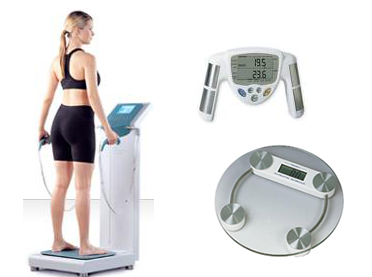Bioelectrical impedance analysis
Bioelectrical impedance analysis (BIA ) is used for determination of body composition in humans and other animals. This BIA method has been developed in recent years the method of choice. More than 2000 publications in scientific journals ensure the accuracy and validity for the interesting body compartments represent:
- Body water ( TBW ), total body water
- Body cell mass (BCM ), body cell mass
- Extracellular Mass (ECM ), Extracellular mass
The internationally agreed scientific standardization for the BIA require a defined measurement positioning. The measuring person lies supine relaxed in the horizontal and the limbs are slightly angled from the fuselage. The placement of the adhesive electrodes must be scrupulously observed. Therefore, an instruction and training of the measuring staff is essential.
Principle
With the constant signal of an alternating current of 0.8 mA at a frequency of 50 kHz, the resistance (impedance, Z) is measured in the body. Two external electrodes, an electromagnetic field is built up in the body. Two other electrodes in the interior of this field, the voltage drop and the phase shift of the signal voltage is measured ( four-wire measurement). The positioning of the electrodes in this " internal measurement path " can be somewhat confusing for a valid and repeatable BIA measurement.
The resistance of the ac resistance R Resistance and reactance Xc. The induction has no meaning for the BIA. The resistances depend on the length and the volume of the body and the composition of different conductive tissues and organs of the body. The intra-and extracellular body fluids as electrolytes primarily define the resistance R. The capacitor cell membranes show effects that can be explained by the structure and charges of the double -layer membranes and cause the Xc share.
To measure the BIA means of a measurement equal to 2 values show the different biological properties:
- R: the effective resistance R analyzes the body fluid status
- Xc: the sum of all membrane capacity Xc is the reference to the quantity, the body cell mass BCM and quality of the body's cells.
With only minor variations, there is a fat-free mass (FFM - see definition in models below) to 74 % water. Thus, can be a direct physiological connection between the resistor and the conductive compartments. Adipose tissue is one of the insulators, so a poor conductor and has a high effective resistance (R). Healthy cell systems generate with their intact cell membranes a high capacitive reactance Xc. From the phenomenon have high Xc values indicate an intact energy state of the cells, so a good nutritional status. Malnutrition and diseases show characteristic deficits that typically are reflected in the ratio of the two resistors to each other. This value is called phase angle ( pA). The higher the Xc share of the total impedance Z, the larger the phase angle. Healthy, well-nourished, sporty and well muskulierte bodies are characterized by a large phase angle. Diseases and malnutrition and diet as well as physical inactivity, reducing the phase angle.
There are also changes in the body fluids in the distribution spaces measurable. Thus, physiological and therefore dynamic processes with special BIA formulas ( multiple regression equations) can be represented. About the fluctuations of body fluid content in the course of a day can be very accurately measured by the change in conductivity. The sets of formulas have been developed from studies in comparative analyzed reference methods.
Consumer devices for bioelectrical impedance analysis in body fat scales, the measurements of the lower extremities and the lower trunk area to perform, as well as hand-hand instruments, which supply the upper limbs and upper torso area with a measuring signal does not correspond to the minimum necessary requirements for a BIA. The body weight increases in the formulas of these devices a dominant function. Such an increase in weight is defined as a more fat, a reduction in weight depicted as a fat loss, even if primary muscles were removed. Therefore, these devices are not recommended from a medical perspective.
Prerequisites for correct body analysis by BIA:
Normal values
The international initiative of the working group " AG WissenSchafftBilder " published with the " body analysis normal values , BIAdata " BIAdata -project their new, scientifically based normal value tables for the fat content and muscle mass. Called for fair-skinned people of Europe, Caucasian (also for the white, non- Hispanic population valid), for the first time, there are statistically reliable normal values for the entire age transition from birth to the age of 100 years:
Body compartments
There are four different Körperkompartimentmodelle, which can be determined using the bioelectrical impedance analysis:
Also, the BMI falls into this category. An evaluation of the " overweight " as a definition of too much fat is not possible. A well-trained muscles are well defined as overweight.
- 2 -compartment model: This model divides the body into body fat (FM) and fat-free mass (FFM ) (often referred to synonymously as lean mass ( lean body mass, LBM ), the LBM contains residual fats, such as intramuscular fat accumulation In. the FFM is the rest of the means of ether extracted fat free mass ). For measurements in this model, a compartment is determined directly and the other is calculated as the difference to body weight.
- 3 -compartment model: This model extends the two -compartment model by dividing the FFM in body cell mass (BCM ) and extracellular mass (ECM). The body cell mass is defined by Moore as the sum of the oxygen consuming, oxidizing glucose, potassium-rich and labor payable cells.
- 3 -compartment model with ICW and ECW: It is introduced in addition to the 3 -compartment model expulsion of the components of body water. These components are the intracellular water (ICW ), which is a part of the cells of the body (BCM), and the extracellular water ( ECW), which is located outside of the cells and thus is a part of the ECM.










